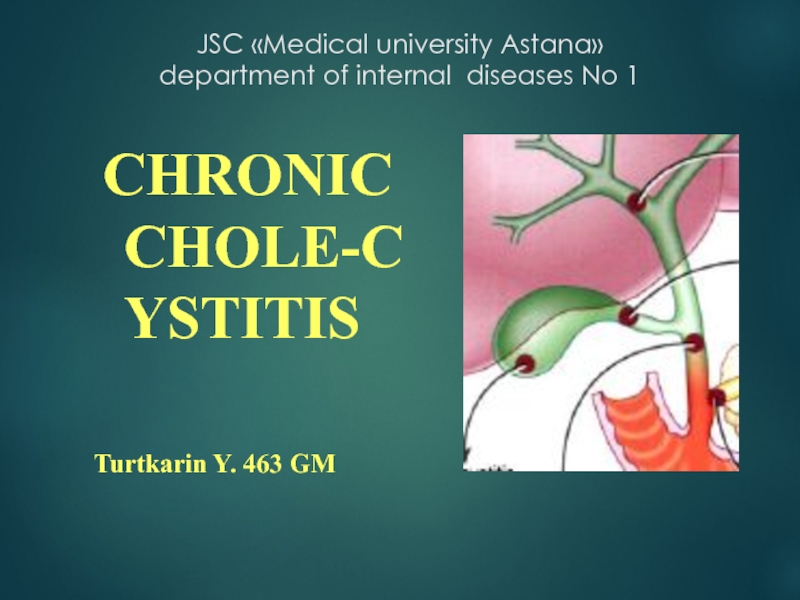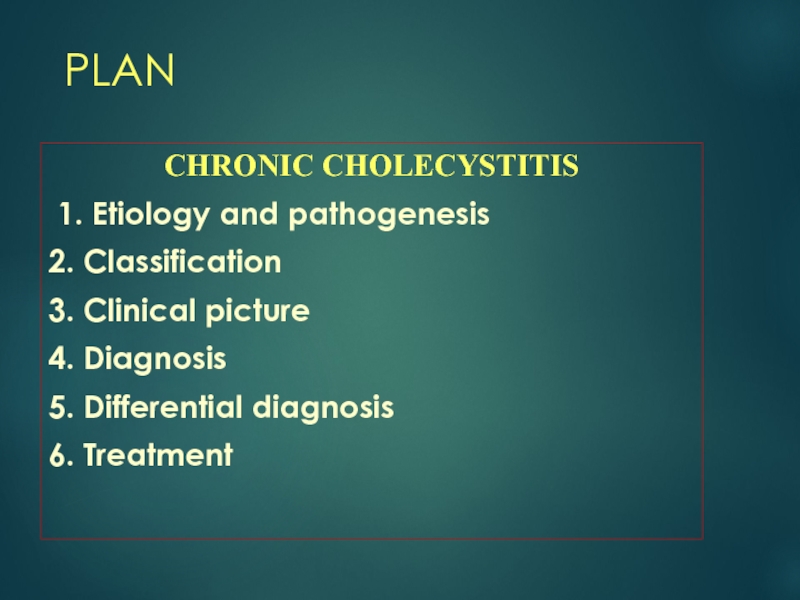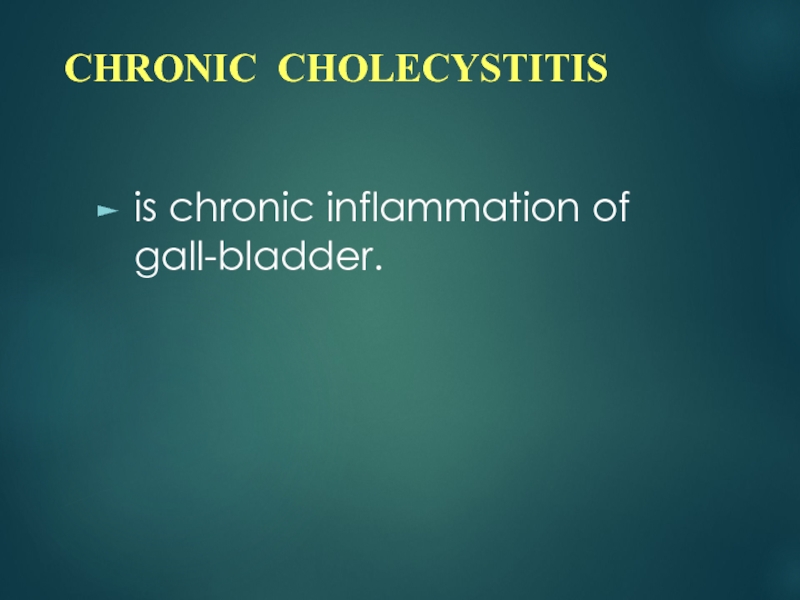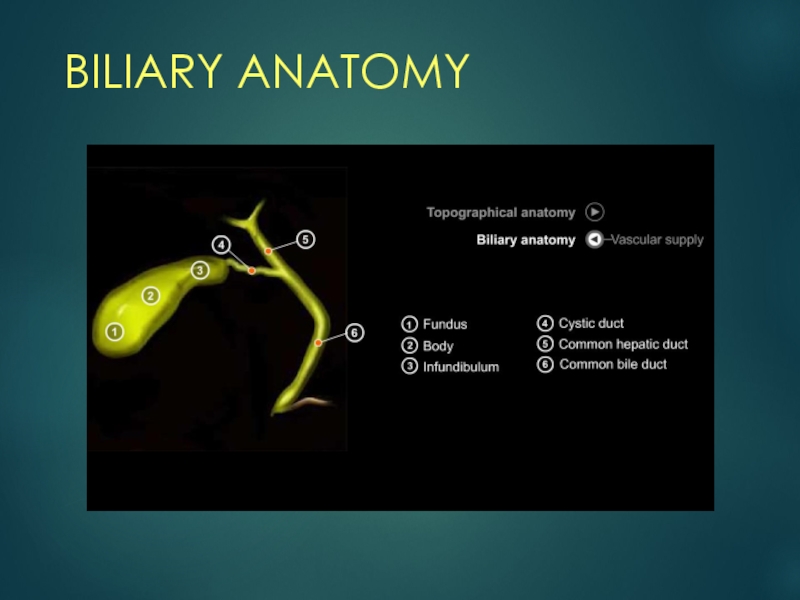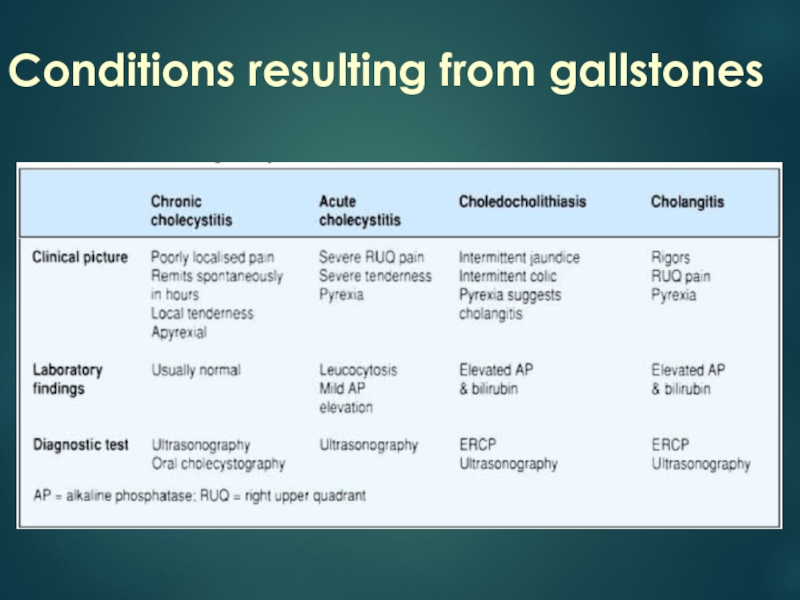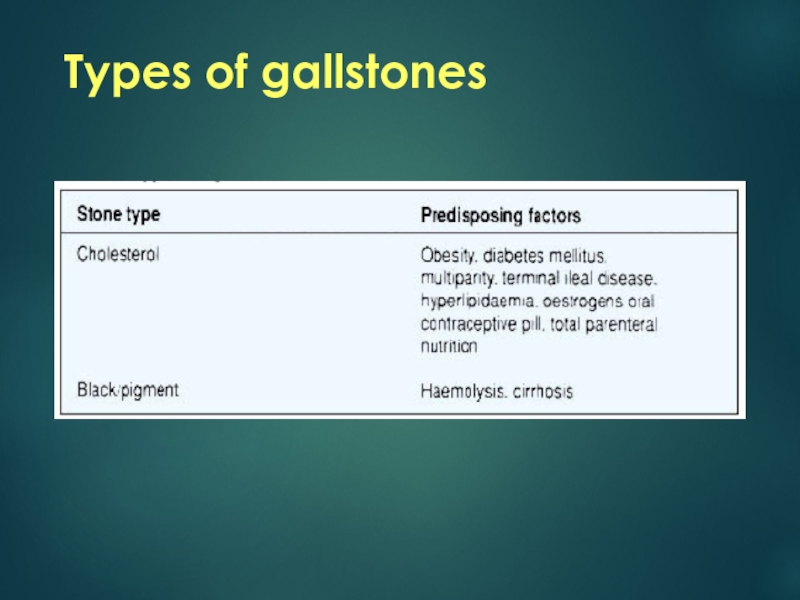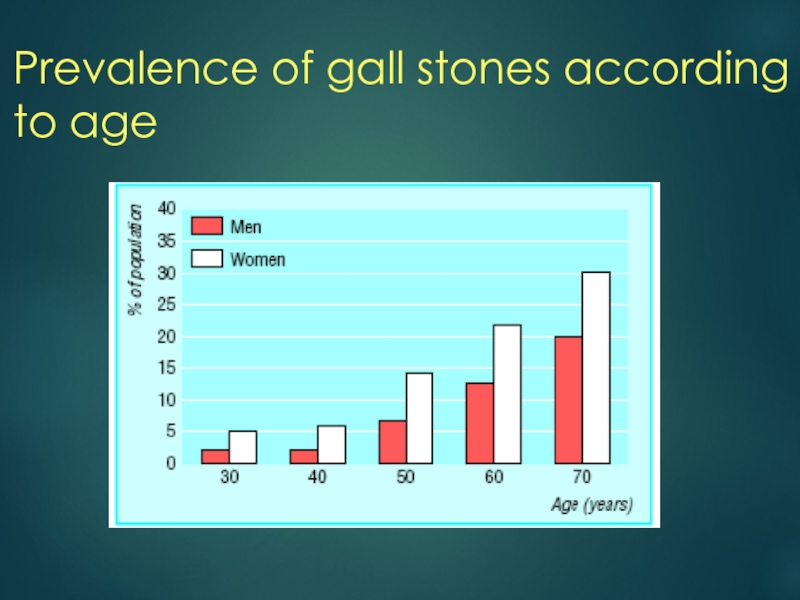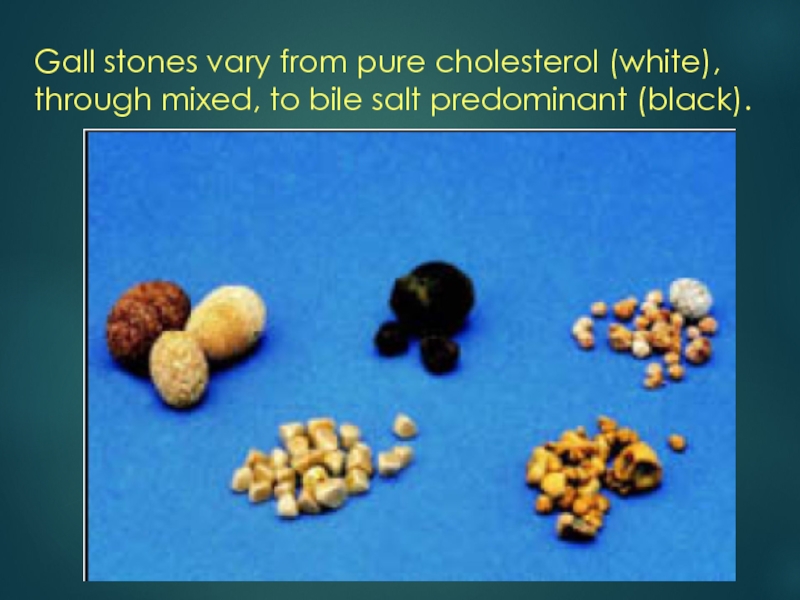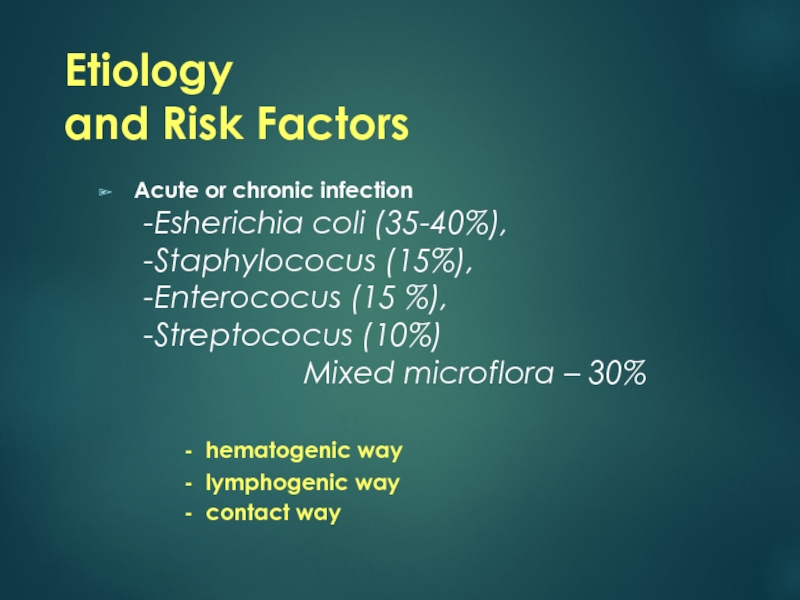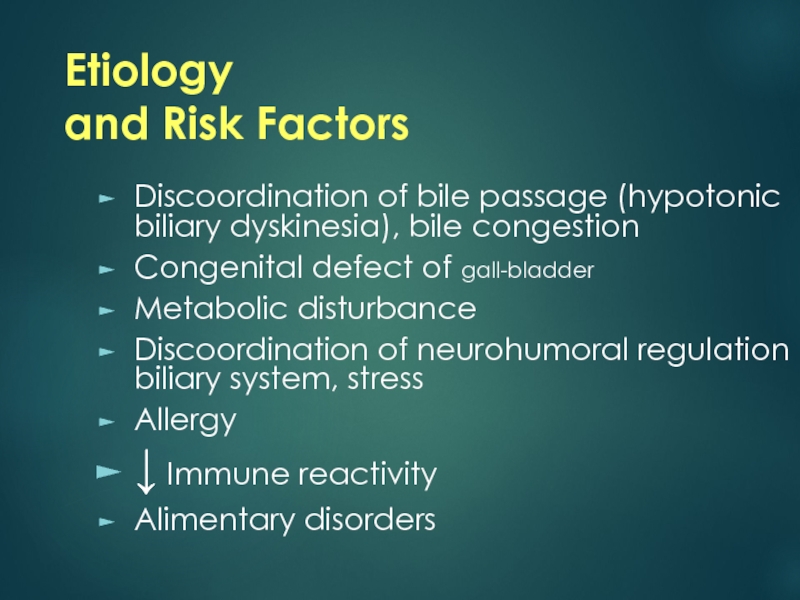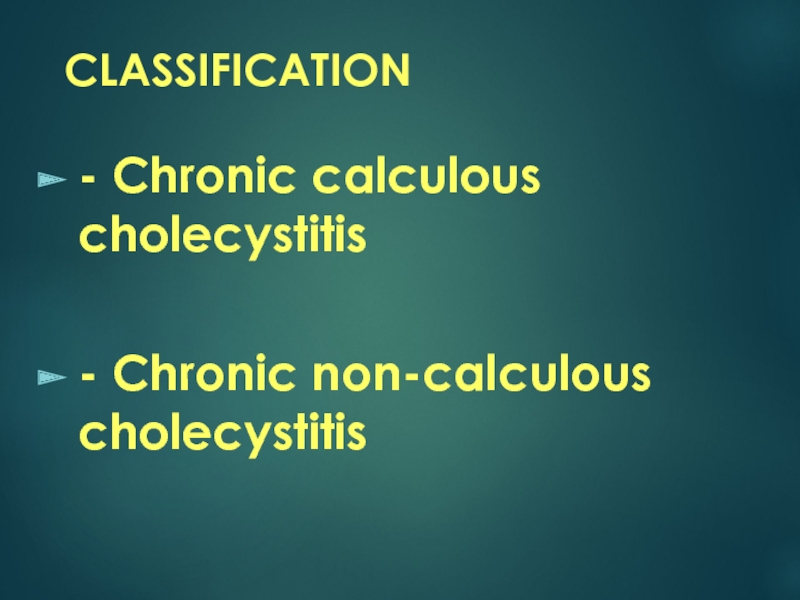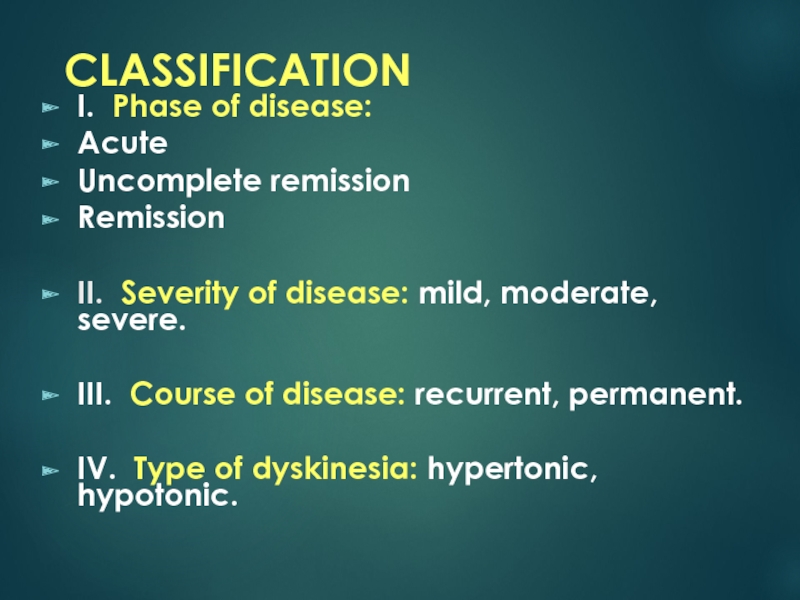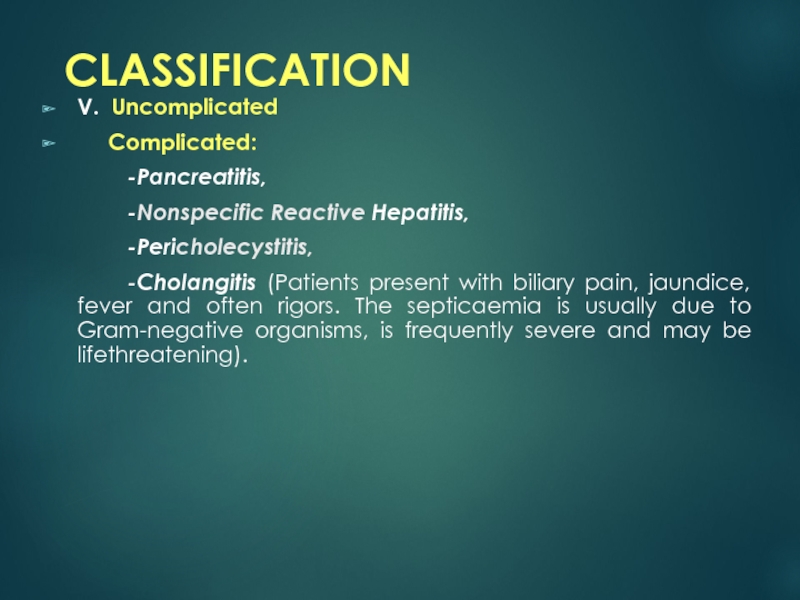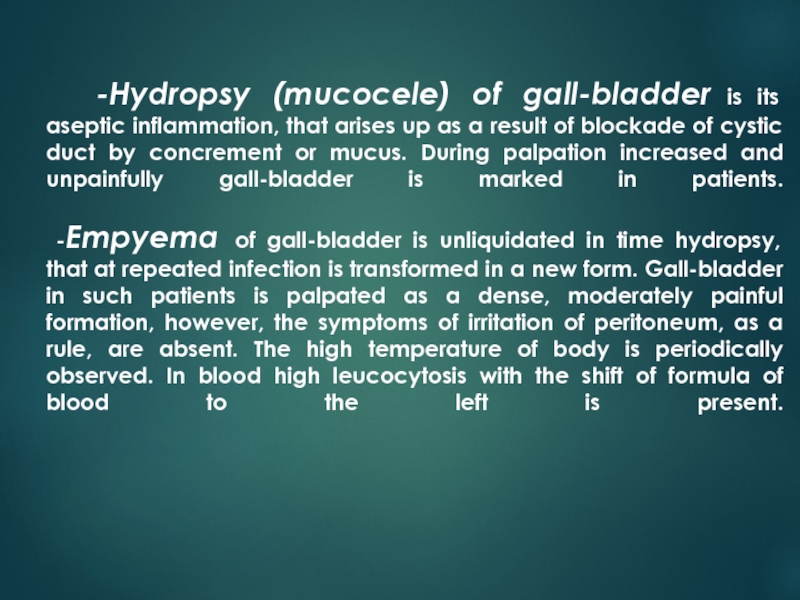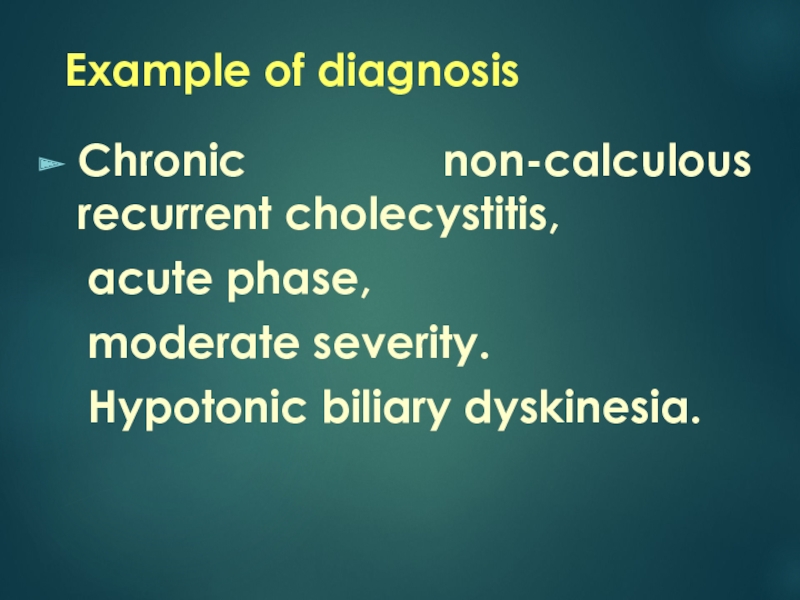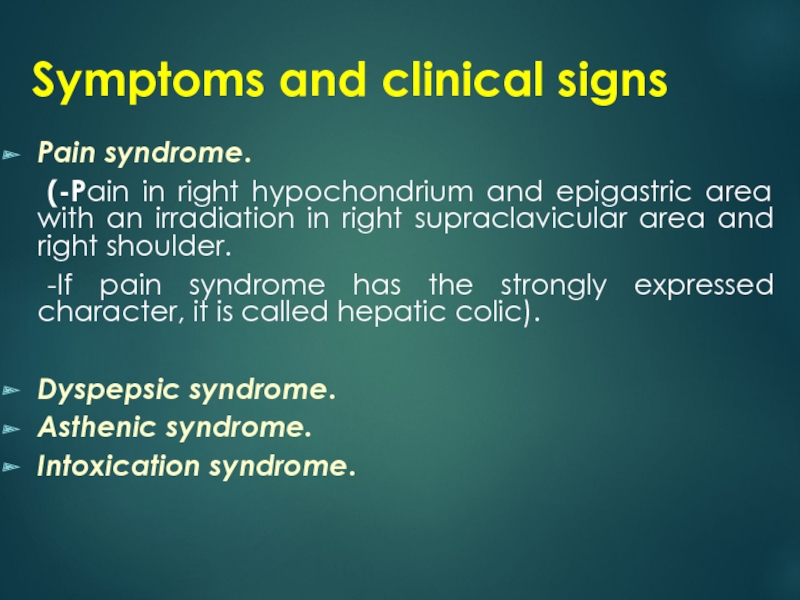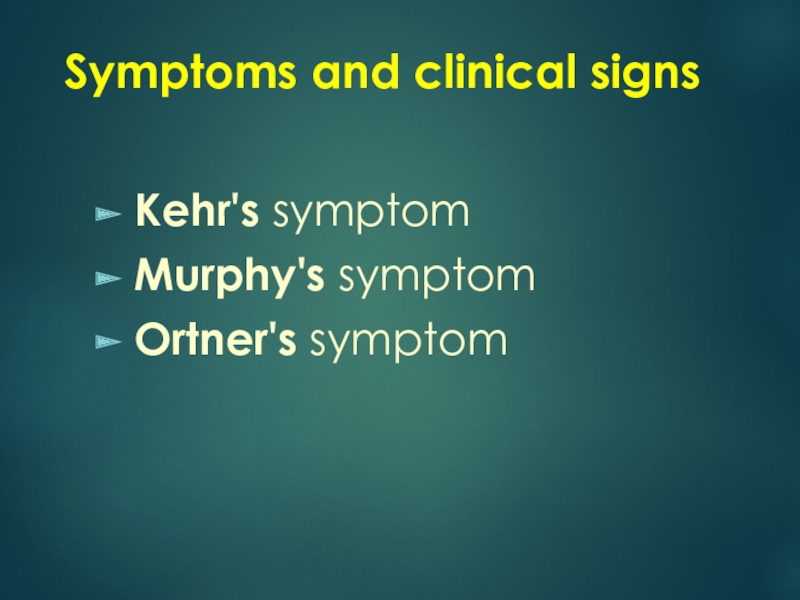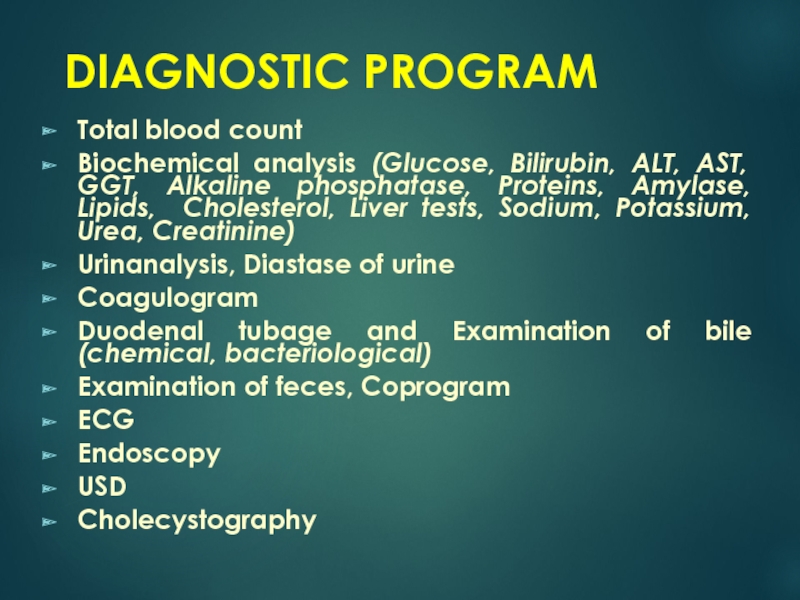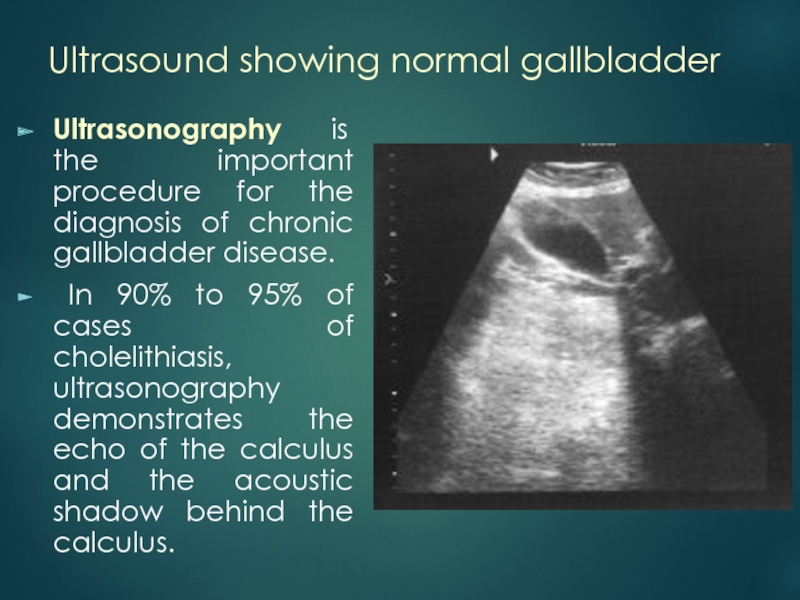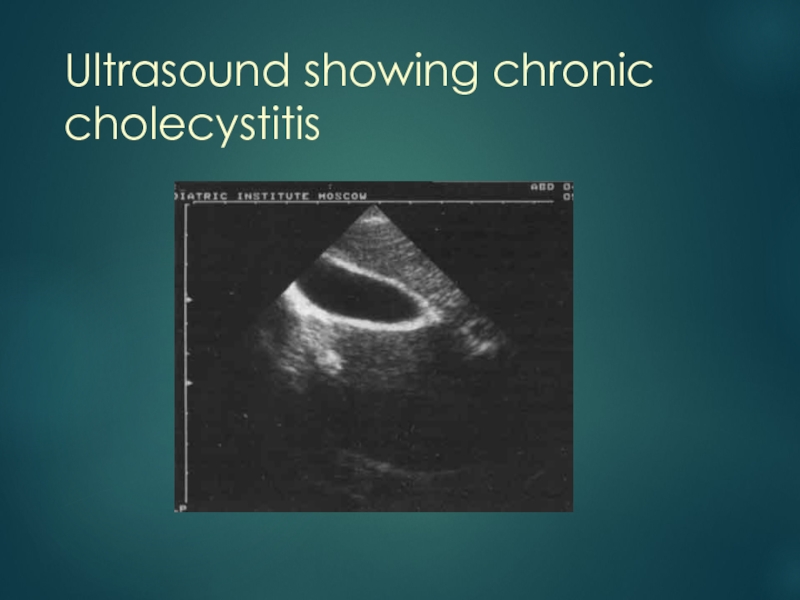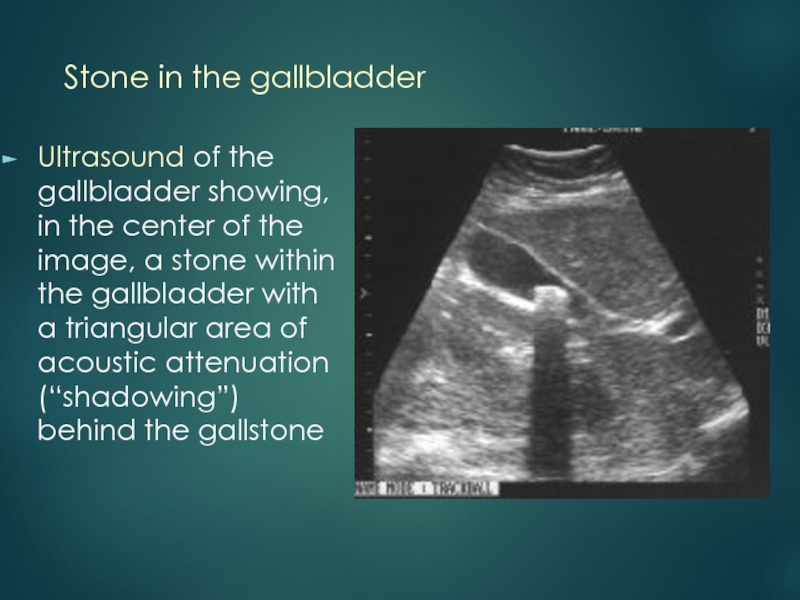CHOLE-CYSTITIS
Turtkarin Y. 463 GM
- Главная
- Разное
- Дизайн
- Бизнес и предпринимательство
- Аналитика
- Образование
- Развлечения
- Красота и здоровье
- Финансы
- Государство
- Путешествия
- Спорт
- Недвижимость
- Армия
- Графика
- Культурология
- Еда и кулинария
- Лингвистика
- Английский язык
- Астрономия
- Алгебра
- Биология
- География
- Детские презентации
- Информатика
- История
- Литература
- Маркетинг
- Математика
- Медицина
- Менеджмент
- Музыка
- МХК
- Немецкий язык
- ОБЖ
- Обществознание
- Окружающий мир
- Педагогика
- Русский язык
- Технология
- Физика
- Философия
- Химия
- Шаблоны, картинки для презентаций
- Экология
- Экономика
- Юриспруденция
Chronic cholecystitis презентация
Содержание
- 1. Chronic cholecystitis
- 2. PLAN CHRONIC CHOLECYSTITIS 1. Etiology and
- 3. CHRONIC CHOLECYSTITIS is chronic inflammation of gall-bladder.
- 4. BILIARY ANATOMY
- 5. Conditions resulting from gallstones
- 6. Types of gallstones
- 7. Prevalence of gall stones according to age
- 8. Gall stones vary from pure cholesterol (white), through mixed, to bile salt predominant (black).
- 9. Etiology and Risk Factors Acute or
- 10. Etiology and Risk Factors Discoordination of
- 11. CLASSIFICATION - Chronic calculous cholecystitis - Chronic non-calculous cholecystitis
- 12. CLASSIFICATION I. Phase of disease: Acute
- 13. CLASSIFICATION V. Uncomplicated
- 14. -Hydropsy (mucocele) of gall-bladder is its
- 15. Example of diagnosis Chronic non-calculous
- 16. Symptoms and clinical signs Pain syndrome.
- 17. Symptoms and clinical signs Kehr's symptom Murphy's symptom Ortner's symptom
- 18. DIAGNOSTIC PROGRAM Total blood count Biochemical analysis
- 19. Ultrasound showing normal gallbladder Ultrasonography is
- 20. Ultrasound showing chronic cholecystitis
- 21. Stone in the gallbladder Ultrasound
- 22. Ultrasound image of gall bladder
- 23. Cholecysto-graphy. Cholelithiasis
- 24. This magnetic resonance cholangiopancreato-gram shows
- 25. Differential diagnosis Peptic ulcer disease Chronic pancreatitis
- 26. TREATMENT Acute cholecystitis requires analgesia, intravenous support
- 27. TREATMENT 1. Bed rest. 2. Hunger
- 28. CHOLANGITIS Acute cholangitis is a serious infection
- 29. Medical management of gallbladder stones Dissolution therapy
- 30. Indications for Surgical Treatment All forms of
Слайд 2PLAN
CHRONIC CHOLECYSTITIS
1. Etiology and pathogenesis
2. Classification
3. Clinical picture
4. Diagnosis
5. Differential
diagnosis
6. Treatment
6. Treatment
Слайд 8Gall stones vary from pure cholesterol (white), through mixed, to bile
salt predominant (black).
Слайд 9Etiology
and Risk Factors
Acute or chronic infection
-Esherichia coli (35-40%),
-Staphylococus (15%),
-Enterococus (15
%),
-Streptococus (10%)
Mixed microflora – 30%
- hematogenic way
- lymphogenic way
- contact way
-Streptococus (10%)
Mixed microflora – 30%
- hematogenic way
- lymphogenic way
- contact way
Слайд 10Etiology
and Risk Factors
Discoordination of bile passage (hypotonic biliary dyskinesia), bile congestion
Congenital
defect of gall-bladder
Metabolic disturbance
Discoordination of neurohumoral regulation of biliary system, stress
Allergy
↓ Immune reactivity
Alimentary disorders
Metabolic disturbance
Discoordination of neurohumoral regulation of biliary system, stress
Allergy
↓ Immune reactivity
Alimentary disorders
Слайд 12CLASSIFICATION
I. Phase of disease:
Acute
Uncomplete remission
Remission
II. Severity of disease: mild, moderate, severe.
III. Course of disease: recurrent, permanent.
IV. Type of dyskinesia: hypertonic, hypotonic.
Слайд 13CLASSIFICATION
V. Uncomplicated
Complicated:
-Pancreatitis,
-Nonspecific Reactive Hepatitis,
-Pericholecystitis,
-Cholangitis (Patients
present with biliary pain, jaundice, fever and often rigors. The septicaemia is usually due to Gram-negative organisms, is frequently severe and may be lifethreatening).
Слайд 14
-Hydropsy (mucocele) of gall-bladder is its aseptic inflammation, that arises up
as a result of blockade of cystic duct by concrement or mucus. During palpation increased and unpainfully gall-bladder is marked in patients.
-Empyema of gall-bladder is unliquidated in time hydropsy, that at repeated infection is transformed in a new form. Gall-bladder in such patients is palpated as a dense, moderately painful formation, however, the symptoms of irritation of peritoneum, as a rule, are absent. The high temperature of body is periodically observed. In blood high leucocytosis with the shift of formula of blood to the left is present.
Слайд 15Example of diagnosis
Chronic non-calculous recurrent cholecystitis,
acute phase,
moderate severity.
Hypotonic biliary
dyskinesia.
Слайд 16Symptoms and clinical signs
Pain syndrome.
(-Pain in right hypochondrium and epigastric
area with an irradiation in right supraclavicular area and right shoulder.
-If pain syndrome has the strongly expressed character, it is called hepatic colic).
Dyspepsic syndrome.
Asthenic syndrome.
Intoxication syndrome.
-If pain syndrome has the strongly expressed character, it is called hepatic colic).
Dyspepsic syndrome.
Asthenic syndrome.
Intoxication syndrome.
Слайд 18DIAGNOSTIC PROGRAM
Total blood count
Biochemical analysis (Glucose, Bilirubin, ALT, AST, GGT, Alkaline
phosphatase, Proteins, Amylase, Lipids, Cholesterol, Liver tests, Sodium, Potassium, Urea, Creatinine)
Urinanalysis, Diastase of urine
Coagulogram
Duodenal tubage and Examination of bile (chemical, bacteriological)
Examination of feces, Coprogram
ECG
Endoscopy
USD
Cholecystography
Urinanalysis, Diastase of urine
Coagulogram
Duodenal tubage and Examination of bile (chemical, bacteriological)
Examination of feces, Coprogram
ECG
Endoscopy
USD
Cholecystography
Слайд 19Ultrasound showing normal gallbladder
Ultrasonography is the important procedure for the
diagnosis of chronic gallbladder disease.
In 90% to 95% of cases of cholelithiasis, ultrasonography demonstrates the echo of the calculus and the acoustic shadow behind the calculus.
In 90% to 95% of cases of cholelithiasis, ultrasonography demonstrates the echo of the calculus and the acoustic shadow behind the calculus.
Слайд 21Stone in the gallbladder
Ultrasound of the gallbladder showing, in the
center of the image, a stone within the gallbladder with a triangular area of acoustic attenuation (“shadowing”) behind the gallstone
Слайд 22
Ultrasound image of gall bladder with dark area (a) representing gall
bladder and multiple white echoes (b) representing stones.
Bottom: The gall bladder after cholecystectomy with multiple small stones
Bottom: The gall bladder after cholecystectomy with multiple small stones
Слайд 24
This magnetic resonance cholangiopancreato-gram shows multiple gallstones (arrows) in the common
bile duct (choledocholithiasis)
Слайд 25Differential diagnosis
Peptic ulcer disease
Chronic pancreatitis
Chronic hepatitis
Tumors (liver, gall bladder)
Pleurisy (right-sided)
Subdiaphragmatic abscess
Слайд 26TREATMENT
Acute cholecystitis requires analgesia, intravenous support and antibiotics, and usually settles
with these measures.
Subsequent cholecystectomy may then be performed when the acute episode has resolved.
Careful selection of patients with chronic cholecystitis is important as not all patients are pain-free when the gallbladder is removed; symptoms may abate spontaneously and not recur; and there is an increasing, associated, operative mortality with advancing age.
Laparoscopic cholecystectomy has increased the acceptability of the procedure for patients and has consequently become widely available.
Subsequent cholecystectomy may then be performed when the acute episode has resolved.
Careful selection of patients with chronic cholecystitis is important as not all patients are pain-free when the gallbladder is removed; symptoms may abate spontaneously and not recur; and there is an increasing, associated, operative mortality with advancing age.
Laparoscopic cholecystectomy has increased the acceptability of the procedure for patients and has consequently become widely available.
Слайд 27TREATMENT
1. Bed rest.
2. Hunger (1–3 days), then diet № 5.
3. Desintoxication therapy.
4. Spasmolytics, Analgetics (Spasmalgon 5 ml, No-shpa 2% 2 ml, Papaverin 2% 2 ml, Platyphyllin 0,1% 1 ml, Baralgin 5 ml, Analgin 50% 2 ml).
5. Antibacterial therapy (Ampiox, Ofloxacin, Cephalosporines, Furasolidon)
Слайд 28CHOLANGITIS
Acute cholangitis is a serious infection which may be life-threatening.
Antibiotics
such as third generation cephalosporins or amino-quinolones should be used.
Careful attention should be paid to fluid balance, urine output and renal function.
Careful attention should be paid to fluid balance, urine output and renal function.
Слайд 29Medical management of gallbladder stones
Dissolution therapy can be considered in patients
with uncomplicated gallstone disease who are unwilling or unfit for surgery.
The prerequisites for treatment are that the stones should be non-calcified, the gallbladder should be functioning and the cystic duct not obstructed.
The bile acids, chenodeoxycholic acid and ursodeoxycholic acid are available and need to be given for long periods to be successful.
They have no effect on pigment stones.
The prerequisites for treatment are that the stones should be non-calcified, the gallbladder should be functioning and the cystic duct not obstructed.
The bile acids, chenodeoxycholic acid and ursodeoxycholic acid are available and need to be given for long periods to be successful.
They have no effect on pigment stones.
Слайд 30Indications for Surgical Treatment
All forms of acute calculous cholecystitis
Destructive and
complicated forms of noncalculous cholecystitis
Acute catarrhal cholecystitis, conservative treatment of which was uneffective
Acute catarrhal cholecystitis, conservative treatment of which was uneffective
